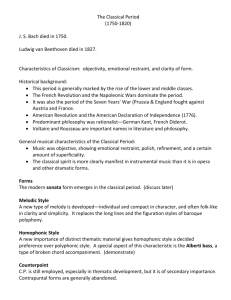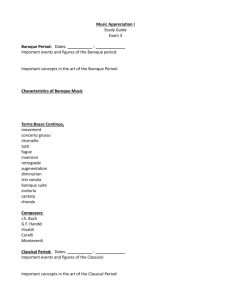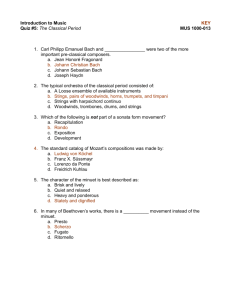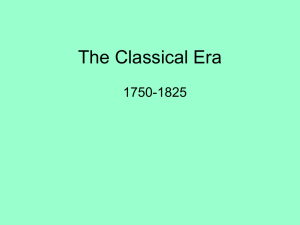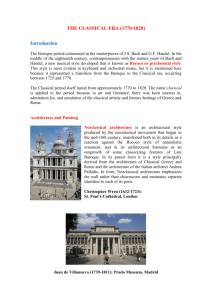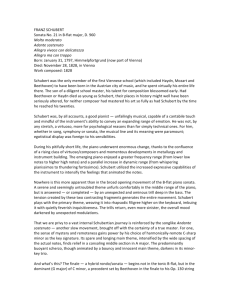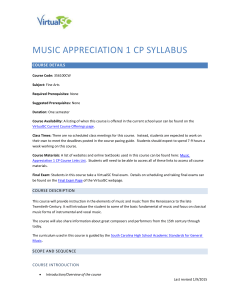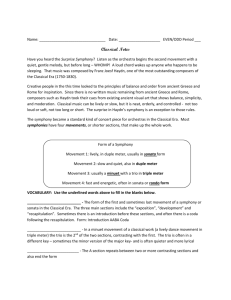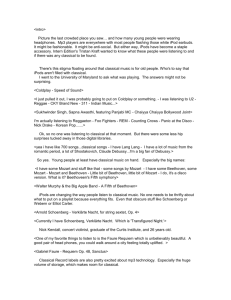Classical Music Info
advertisement
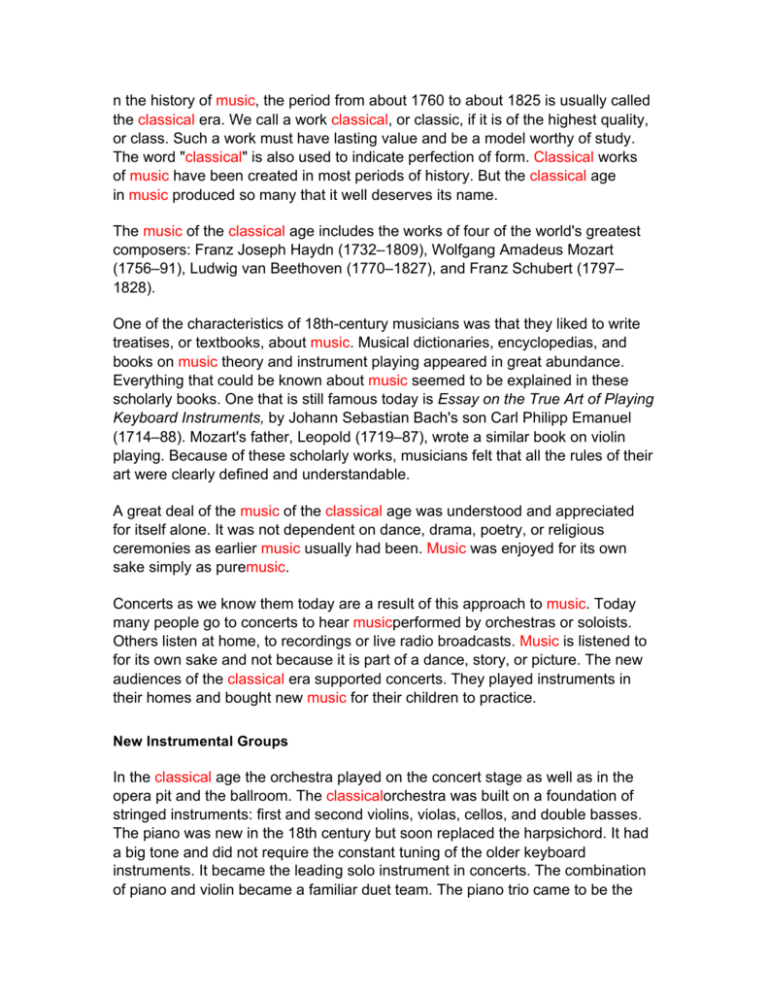
n the history of music, the period from about 1760 to about 1825 is usually called the classical era. We call a work classical, or classic, if it is of the highest quality, or class. Such a work must have lasting value and be a model worthy of study. The word "classical" is also used to indicate perfection of form. Classical works of music have been created in most periods of history. But the classical age in music produced so many that it well deserves its name. The music of the classical age includes the works of four of the world's greatest composers: Franz Joseph Haydn (1732–1809), Wolfgang Amadeus Mozart (1756–91), Ludwig van Beethoven (1770–1827), and Franz Schubert (1797– 1828). One of the characteristics of 18th-century musicians was that they liked to write treatises, or textbooks, about music. Musical dictionaries, encyclopedias, and books on music theory and instrument playing appeared in great abundance. Everything that could be known about music seemed to be explained in these scholarly books. One that is still famous today is Essay on the True Art of Playing Keyboard Instruments, by Johann Sebastian Bach's son Carl Philipp Emanuel (1714–88). Mozart's father, Leopold (1719–87), wrote a similar book on violin playing. Because of these scholarly works, musicians felt that all the rules of their art were clearly defined and understandable. A great deal of the music of the classical age was understood and appreciated for itself alone. It was not dependent on dance, drama, poetry, or religious ceremonies as earlier music usually had been. Music was enjoyed for its own sake simply as puremusic. Concerts as we know them today are a result of this approach to music. Today many people go to concerts to hear musicperformed by orchestras or soloists. Others listen at home, to recordings or live radio broadcasts. Music is listened to for its own sake and not because it is part of a dance, story, or picture. The new audiences of the classical era supported concerts. They played instruments in their homes and bought new music for their children to practice. New Instrumental Groups In the classical age the orchestra played on the concert stage as well as in the opera pit and the ballroom. The classicalorchestra was built on a foundation of stringed instruments: first and second violins, violas, cellos, and double basses. The piano was new in the 18th century but soon replaced the harpsichord. It had a big tone and did not require the constant tuning of the older keyboard instruments. It became the leading solo instrument in concerts. The combination of piano and violin became a familiar duet team. The piano trio came to be the standard grouping of piano, violin, and cello. The string quartet—two violins, viola and cello—began its exciting development. Classical Musical Forms New ideas about music and the new instrumental groupings led composers to develop new musical forms. The classical forms were closely related to the classical sonata. The word "sonata" is very old and has been used in a variety of ways. In themusic of the classical age, it has a special meaning. Sonata Form The word "sonata" comes from the Italian sonare, "to play." Before the classical age any piece of instrumental music could be called a sonata. When baroque composers began writing long instrumental works of several parts, they called them sonatas. These were the first sonatas consisting of several movements. (A movement is a section of composition that is divided into separate contrasting parts.) Many of them are still played today. Classical composers invented new forms for the sonata. It continued to be an instrumental piece with several movements. The structure of the first movement in a classical sonata came to be called sonata form. This is the special and important meaning of the word "sonata." It is the name for the most important musical form of the classical age. Sonata form has three main parts: exposition, development, and recapitulation. The exposition presents the themes, or subject matter, of the movement. It consists of usually two or three main themes of contrasting character. The development section works out, or develops, the themes of the exposition. It is a test for the composer's musical imagination. He tries to vary the melodies and rhythms in the most interesting way he can. The development may be short or long. It may use only one or all of the themes given in the exposition. It usually moves rapidly through several different keys. It ends with a return to the main theme, which begins the recapitulation. The recapitulation repeats the exposition, often with important changes, and concludes the movement. In the sonata form the composer seems to be saying to us: "These are the subjects I will talk about" (exposition); "Now I discuss them" (development); "This is what I have tried to tell you" (recapitulation). The sonata form proved so useful that composers used it in many pieces not called sonatas. It was used in opera overtures, chamber music, and symphonies. Thus, a symphony is really a sonata for orchestra. A string quartet is a sonata for four stringed instruments. Sonata form was also used for movements other than the first. Sometimes it was used two or three times in the same work. All four movements of Beethoven's great Seventh String Quartet are in sonata form. Sonata form has been used as a model by almost every composer since the 18th century. It is the most important and characteristic heritage of the classical age in music. Minuet-Trio, Theme and Variations, and Rondo In addition to sonata form, other classical forms included the minuet-trio, the theme-and-variations form, and the rondo. The minuet-trio came from the ballroom, court ballet, and opera. It is in a three-part, or A–B–A, form. The minuet is a short piece, the trio another. After they are both played, the minuet is repeated, thus completing the piece. The theme-and-variations form consists of a theme, or melody, followed by a series of variations on the theme. Each variation is a repeat of the theme but with some aspect of the music changed. In a rondo the main melody alternates with a number of contrasting sections, or episodes. The chief feature of a rondo is the constant return of the first melody. All these forms show endless possibilities for contrast and variety. A true understanding of them is possible only through an acquaintance with the music itself. Here are easily available examples of each form: Sonata form: Mozart, Symphony No. 40 in G minor (K. 550), first, second, and fourth movements. Minuet-trio: Mozart, Piano Sonata No. 11 in A major (K. 331), second movement. Rondo: Beethoven, Two rondos for piano, Opus 51. Theme and variations: Haydn, Symphony No. 94 in G major (Surprise), second movement. Opera in the Classical Age Long before the classical age people had begun to tire of the old-style opera. It was thought to be too artificial. The stories were not lifelike and were often rather silly and complicated. The music and the action did not blend well. The dissatisfaction with this kind of opera came to a climax at the beginning of the classical age. Christoph Willibald Gluck (1714–87) decided to reform the opera. He began his reforms with Orpheus and Eurydice (1762). Gluck gave the opera nobility and dramatic life. He made the music closely follow the action of the story. The music is simple and natural. The singers seem like real people with real feelings and passions. All these qualities are found in the great operas by Gluck, which include Alceste (1767), Iphigenia in Aulis (1774), and Iphigenia in Tauris (1779). Gluck's reforms attracted worldwide attention and strongly influenced opera composers who came after him. The development of opera buffa, or comic opera, contributed to operatic reform. Opera buffa used contemporary stories and characters that came alive on the stage. The increasing use of native languages in opera also aided the reform. Most of the earlier operas were sung in Italian. Hundreds of operas were written in the classical age. Those by Mozart are most characteristic of the period. The Marriage of Figaro, Don Giovanni, Così fan tutte, and The Magic Flute are Mozart's finest and most famous operas. The first three have Italian texts, and the stories contain strong comic elements. The Magic Flute is in German and also features broad comic scenes. All four operas made biting comments on the weaknesses and ideals of the people in the audience. After Mozart, opera began to lose some of its classical qualities. Some of the characteristics of later Italian opera appear in the operas of Domenico Cimarosa (1749–1801) and Gioacchino Rossini (1792–1868). During the Revolutionary and Napoleonic eras, French opera was represented by the works of André Grétry (1741–1813) and Luigi Cherubini (1760–1842). Beethoven's only opera, Fidelio (1805), is a unique masterpiece. It has a German text with spoken dialogue. The Lied One of the important developments in the classical age was the appearance in Germany and Austria of the lied. A lied is a song with piano accompaniment that reflects the meaning and feeling of the poem being sung. The expressive capabilities of the piano made it well suited for this type of song. Franz Schubert was the greatest composer of this kind of song. He inspired a succession of great song composers that flourished until late in the 19th century. A great number of Schubert's songs areclassical examples of the lied. However, they expressed some of the musical ideals of the period that followed. The Viennese Classical Composers Haydn, Mozart, Beethoven, and Schubert were the greatest composers of the classical era. Mozart was a pupil of Haydn's brother and a friend of Haydn himself. Beethoven went to Vienna to study with Mozart. He played for him but was then called back to Bonn by his mother's illness and death. When Beethoven returned to Vienna, Mozart was dead, so he took lessons from Haydn. Schubert spent his life in Vienna, where Beethoven lived. He served as a torchbearer at Beethoven's funeral. By Beethoven's and Schubert's time, Vienna had become the center of the musical world. Vienna was the city in which all four of these composers worked. Thus, they are often called the Viennese classical composers. These four great men were surrounded by hundreds of active but lesser composers. The orchestra at Mannheim, Germany, was a laboratory for experimenting with the symphony. The composers in Mannheim helped to lay the foundations for the works of Haydn and Mozart. At least two sons of the great Bach, Karl Philipp Emanuel and Johann Christian (1735–82), were important composers. Their music for keyboard had a strong influence on the piano music of both Haydn and Mozart. Haydn is often called the father of the string quartet and the symphony. His 83 string quartets and at least 104 symphonies make him the great originator of all such music. In his short life Mozart composed well over 600 works. With this great genius the classical period reached its highest perfection. Mozart's later operas, the Requiem, the last ten string quartets, several quintets, many of the piano concertos, and at least the last four symphonies are among the great treasures of Western music. Beethoven began in the classical tradition. He mastered all the technical and formal elements of the music of Haydn and Mozart. But in Beethoven's hands classical music began to show some of the characteristics of a later musical style. With Beethoven the development of the piano sonata reached its highest point. His 32 sonatas showed new possibilities for the piano. The length and difficulty of the later sonatas set a new standard for this form. Beethoven also enlarged the symphony and made it express his own personality. His 16 string quartets form the core of the chamber music repertory. Franz Schubert was one of music's greatest melodists. Much of his music seems to have been directly inspired by poetry. Many of his songs are masterpieces of extraordinary beauty. Most of Schubert's great instrumental music received very little attention during his short lifetime. The music lovers of Vienna appreciated Beethoven, but they did not recognize the masterpieces that came from Schubert's pen: the Ninth Symphony, the string quartets, the String Quintet in C, the Piano Trio in B flat, and many others. They were composed in the classical forms. But, like Beethoven's music, they already showed some of the characteristics of the music of the romantic age, the period that followed the classical. Theodore M. Finney University of Pittsburgh See also: Beethoven, Ludwig van; Gluck, Christoph Willibald; Haydn, Joseph; Mozart, Wolfgang Amadeus; Opera;Romanticism (Romanticism in Music);; Schubert, Franz. Go to Top of Page How to cite this article: MLA (Modern Language Association) style: Finney, Theodore M. "Classical Age in Music." The New Book of Knowledge. Grolier Online, 2014. Web. 3 Oct. 2014. Chicago Manual of Style: Finney, Theodore M. "Classical Age in Music." The New Book of Knowledge. Grolier Online http://nbk.grolier.com/ncpage?tn=/encyc/article.html&id=a2005700h&type=0ta (accessed October 3, 2014). APA (American Psychological Association) style: Finney, T. M. (2014). Classical Age in Music. The New Book of Knowledge. Retrieved October 3, 2014, from Grolier Online http://nbk.grolier.com/ncpage?tn=/encyc/article.html&id=a2005700h&type=0ta
